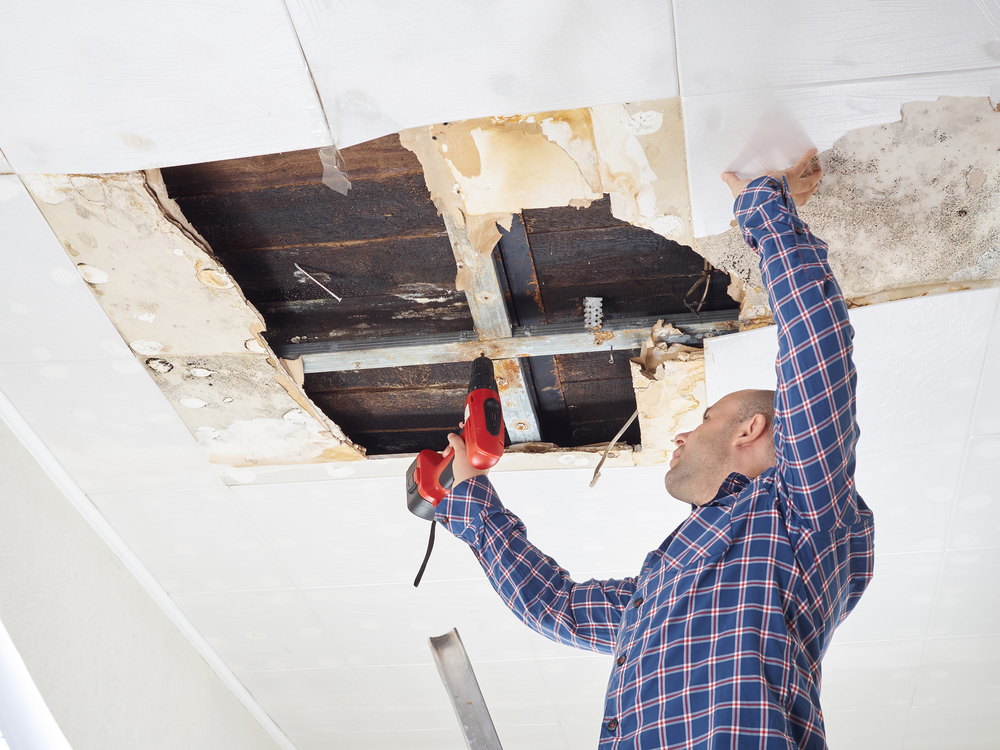Did you know water damage can cause stains, discoloration, and bubbles on drywall? This often means you need to replace it. Replacing drywall can cost between $300 and $400 for materials alone. Labor costs can add up, ranging from $40 to $100 per hour.
This makes the whole process expensive and time-consuming. It can take days or even weeks, depending on how big the job is. Knowing when to replace wet ceiling drywall is key to keeping your home safe and sound.
Key Takeaways
- Water stains, discoloration, and bubbling indicate the need for wet ceiling drywall replacement.
- Average costs for materials range from $300 to $400, excluding labor costs, which can range from $40 to $100 per hour.
- The replacement process can take days to weeks, highlighting the importance of timely intervention.
- Regularly checking for hidden water problems and addressing them promptly is crucial for preventing extensive damage and costly repairs.
Signs of Water Damage in Ceiling Drywall
Spotting signs of water damage in ceiling drywall is key to keeping your home safe and healthy. You need to watch for signs that mean you should fix your ceiling right away.
Water stains and color changes are early signs. These can happen because of different water types and ceiling materials. For example, tile ceilings can change color quickly, sometimes needing new tiles.
Changes in the drywall, like sagging or bubbling, also show water damage. Sagging drywall means it’s not strong anymore and might need to be replaced. Bubbling paint or falling popcorn texture also mean water has gotten in.
Mold on your ceiling is a big warning sign of too much moisture. Mold can harm your ceiling and make you sick. So, fixing water-damaged drywall fast is very important. Wet walls and insulation can lead to mold, which is bad for your health.
Wet joists can also weaken your home’s structure. Finding and fixing the water source quickly is crucial. You can check drywall moisture with special tools or by making small holes.
Getting help from professionals is a good idea if you can’t find the water source or if the damage is bad. They have the right tools and know-how to fix your ceiling right.
Do you have to replace ceiling drywall if it gets wet?
Whether you need to replace wet ceiling drywall depends on several factors. A professional assessment is key. Water damage can lead to structural problems and health risks if not addressed quickly. Here are some important points to remember:
- Visible signs of water damage, such as sagging drywall, softened texture, discoloration, and mold growth, strongly indicate the necessity for replacement.
- The source and duration of wetness play a significant role. Drywall that has been exposed to water for a prolonged period is more likely to require replacement.
- Materials commonly affected by water damage include drywall, cabinets, beams, joists, and insulation. Professional water remediation services can assess the damage and determine whether replacing wet ceiling drywall is essential.
- Companies like Allklean offer comprehensive services, including damage assessments, moisture remediation, and reconstruction, to restore the affected areas safely and effectively.
Repairing wet ceiling drywall might work if the damage is minor and caught early. But if the drywall’s structure is damaged, it must be replaced. This ensures safety and longevity.
Quick action by professionals is crucial. They address water damage signs quickly to prevent further issues. Using quick drying methods can save some materials, but severely damaged drywall often needs to be replaced. This approach is key to maintaining your home’s safety and health.
Conclusion
Whether to replace wet ceiling drywall depends on several key factors. These include the extent of water damage and if mold is present. Signs like watermarks and changes in moisture or texture of the ceiling show water damage. This might mean you need to replace the drywall.
Act fast if you notice a leak. Waiting too long can turn small issues into big problems or health risks from mold. Water damage can get worse in hours to days. It can take days to weeks for a ceiling to dry completely.
Using moisture meters helps figure out the damage level. This helps make the right repair choices.
Getting help from experts is a good idea. They can fix the damage quickly and stop mold. Regular checks and good air flow in places like kitchens and bathrooms help avoid water damage. Fixing water damage early saves money and keeps your home safe and sound.









